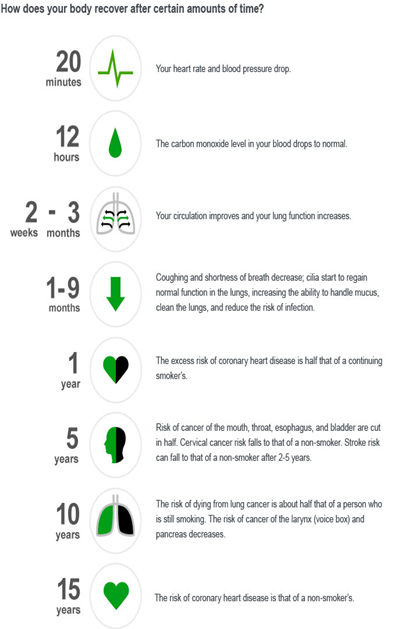
Great American Smokeout Month
By Deborah Hendren, Substance Abuse Prevention Manager
Started in the 1970’s, the Great American Smokeout takes place every year on the third Thursday of November as a way to empower smokers to quit, at least for the day, if not for a lifetime.
Tobacco is the leading cause of preventable and premature death and accounts for an estimated 443,000 deaths (includes those who smoke and those exposed to secondhand smoke) in the United States each year.[i] In 2012, the US adult population smoking rate was 18.1% and the North Carolina adult smoking rate was 20.9%.[ii],[iii] Fourteen percent (14%) of Wake County adult residents report smoking ≥100 cigarettes and currently smoke. [iv]
Smoking is not an individualized health risk activity. In other words, it affects more than just the smoker. It affects those around you. There is no safe level of exposure to secondhand smoke, so choosing to quit benefits not only yourself, but those around you!
Quitting smoking is not an easy task. Here are some tips to overcome the challenge and cravings[v]:
- Take care of yourself – eat right, sleep well, and exercise
- Remove yourself from situations where cigarettes/smoking may be present. Spend time in places where smoking is not permitted or present
- Prevent yourself from doing activities you associated with smoking (for example: stay away from drinking alcohol or coffee; instead, drink water or juice)
- To satisfy your hand-to-mouth habit hold a pencil/pen, toothpick, straw, sugarless gum, sugar-free lollipops, etc.
- Take deep breaths to relax
- Remember your goal to stop smoking and your urges for a cigarette should lessen over time
- Call a friend, family member, or the Quitline when you need extra help or support
To see how your body recovers within minutes of quitting view the graphic below and share with others.
If you want to quit-choose the Great American Smokeout as your quit date! It is November 20, 2014 and you will join thousands of other smokers on the journey to a healthier life!
To learn more about Poe Center programs about tobacco and other drugs, visit:
For more information on tobacco use among youth, visit:
For more information on the Great American Smokeout, visit:
For more information on how to successfully quit, visit:
- http://www.quitlinenc.com/ or call 1-800-Quit-Now
*anyone who registers with the Quitline on November 20th is eligible to receive 8 weeks of
FREE Nicotine Replacement Therapy Patches*
.
[i] Centers for Disease Control and Prevention. (2011). Tobacco Use: Targeting the nation’s Leading Killer. Retrieved August 6, 2014 from http://www.cdc.gov/chronicdisease/resource/publications/aag/osh.htm
[ii] Centers for Disease Control and Prevention. (2012). Current cigarette smoking among adults – United States, 2005-2012. Retrieved August 6, 2014 from http://www.cdc.gov/mmwr/pdf/wk/mm6302.pdf.
[iii] Campaign for Tobacco-Free Kids. (2014). Key state-specific tobacco-related data & rankings. Retrieved August 5, 2014 from http://www.tobaccofreekids.org/research/factsheets/pdf/0176.pdf
[iv] County health rankings indicators and measurements-Wake County, NC-2013. Retrieved July 31, 2014 from http://www.countyhealthrankings.org/app/northcarolina/2014/rankings/wake/county/outcomes/overall/snashotcarolina/2014/rankings/wake/county/outcomes/overall/snapshot
[v] American Cancer Society. (2014). Helping a smoker quit: do’s and don’ts general hints for friends and family. Retrieved August 26, 2014 from http://www.cancer.org/healthy/stayawayfromtobacco/helping-a-smoker-quit
[v]i Mulvihill, Catherine. “Re: GASO Write Up.” Message to Deborah Hendren. 13 November 2014. E-mail.

